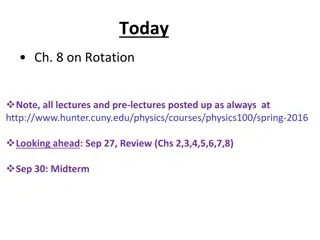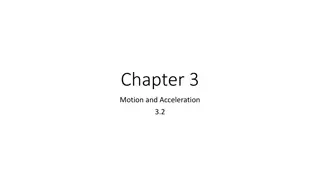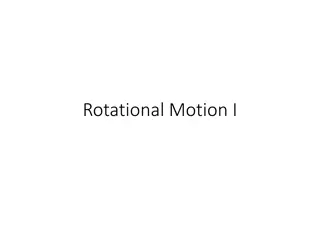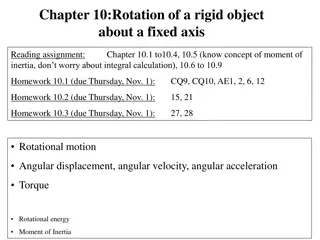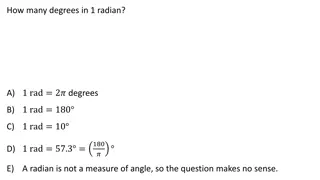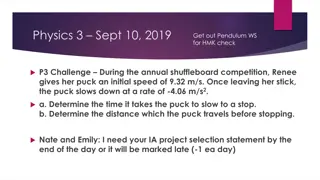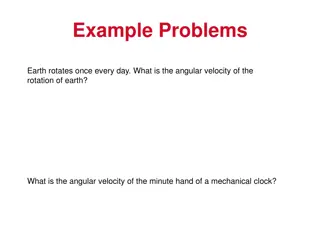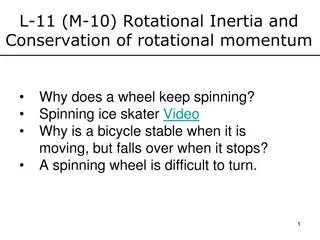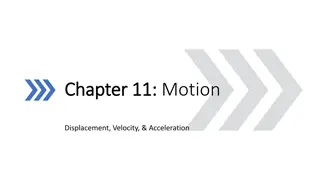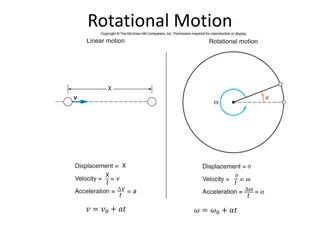Understanding Rotational Motion: Angular Velocity and Acceleration
Explore the concepts of angular velocity, radians, and rotational motion in this educational content. Learn about the relationship between angular and linear velocity, angular acceleration, tangential acceleration, and centripetal acceleration through practical examples. Enhance your understanding of how objects move in circular paths and the measurements used to describe such motion.
Download Presentation

Please find below an Image/Link to download the presentation.
The content on the website is provided AS IS for your information and personal use only. It may not be sold, licensed, or shared on other websites without obtaining consent from the author. Download presentation by click this link. If you encounter any issues during the download, it is possible that the publisher has removed the file from their server.
E N D
Presentation Transcript
Rotational Motion When all points in a body move in circles Can be described in terms of angular velocity and angular acceleration is measured in radians x r
Radian (rad) Angle swept out when the length of the arc (x) is equal to the radius (r) = x/r Radians can be related to degrees 1 rad = 57.3
Example A bird can distinguish objects that are within an area swept out by an angle of 3 x 10-4 radians. A) how many degrees is this? B) How big of an object can be seen when he is flying at an elevation of 100m?
Angular Velocity () Change in over time = / t Unit is rad/s All points in the object rotate with the same angular velocity since any point moves through the same angle in the same time
Angular to Linear Velocity Linear velocity (v) is the velocity tangent to the curve Linear velocity will depend on how far away from the center of the circle you are since at a larger r, the linear distance x will be greater v = r
Example A rotating carousel has one child sitting on a horse near the outer edge and another child on a lion halfway out from the center A) which child has the greater angular speed? B) which child has the greater linear speed?
Angular Acceleration () Change in angular velocity over time = /t = 2 1 t Units rad/s2
Tangential Acceleration Linear acceleration tangent to curve atan = v/ t v = r atan = r/t = /t atan = r
Centripetal Acceleration ar = v2/ r = ( r)2/ r = 2r Centripetal acceleration is greater the farther you are from the axis of rotation
Total Acceleration Sum of tangential and centripetal accelerations Since centripetal and tangential acceleration are perpendicular to each other, it is a vector total for a right triangle + atot = 2 2 ( ) ( ) a ra tan
Example A carousel is initially at rest. At t = 0 it is given a constant angular acceleration = 0.060 rad/s2 for a total of 8.0 s. At 8.0 s, determine a) the angular velocity and b) the linear velocity of a child 2.5m from the center c) tangential acceleration d) centripetal acceleration and d) total acceleration
Frequency Revolutions per second Period (T) time for one revolution T = 1/f v = r v = 2 r/T = 2 rf = 2 f
Example What is the linear and angular speed of a child seated 1.2 m from the center of a steadily rotating merry-go-round that makes one revolution in 4.0 s?
Example What is the frequency and period of a carousel when rotating at an angular velocity of 0.48 rad/s?





